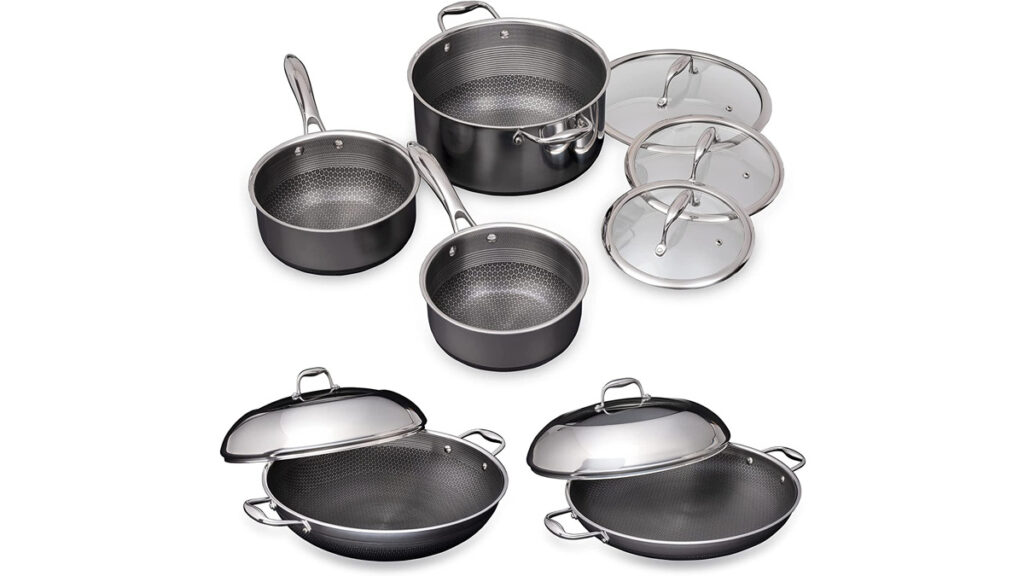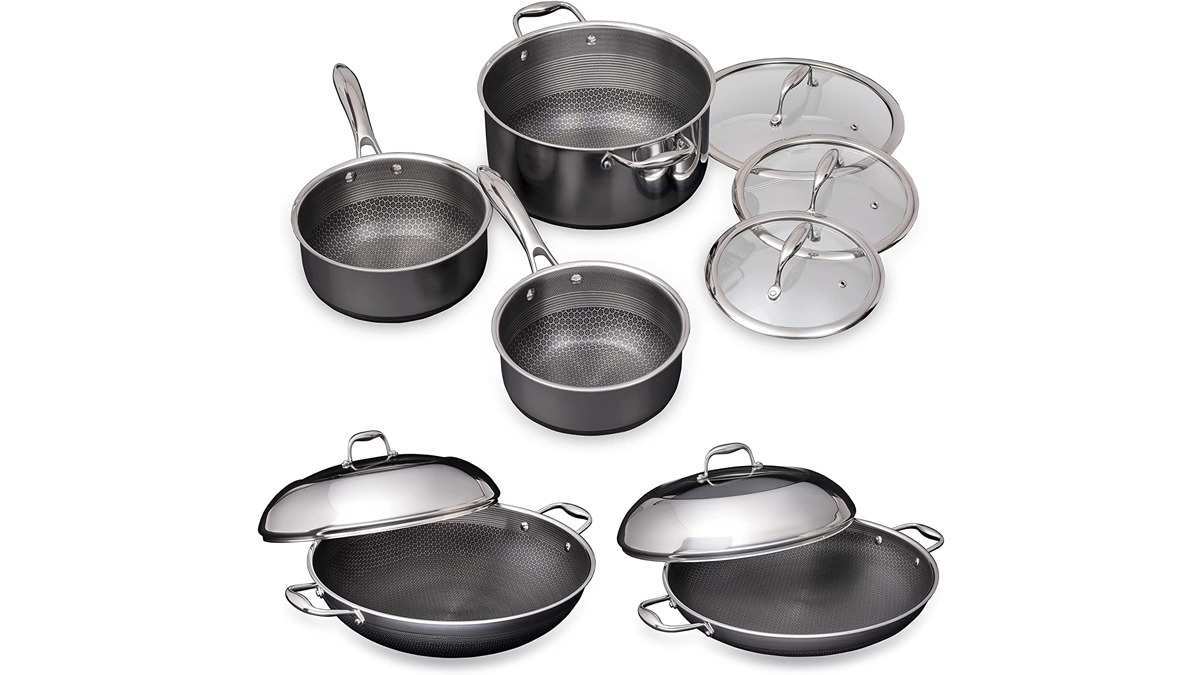
Hexclad vs. All-Clad: The Ultimate Cookware Showdown
Choosing the right cookware is a crucial decision for any home cook, impacting everything from cooking efficiency to the final flavor of your dishes. Among the many options available, Hexclad and All-Clad stand out as premium brands promising exceptional performance and durability. But which one reigns supreme? This comprehensive Hexclad vs All-Clad review dives deep into the features, benefits, and drawbacks of each brand, helping you make an informed choice for your culinary needs. We’ll explore construction, performance, versatility, and value to determine which cookware set deserves a place in your kitchen.
In this in-depth comparison, we’ll examine everything from heat distribution and cooking surface to handle comfort and cleaning ease. We’ll also consider the long-term investment, comparing the longevity and warranty of both Hexclad and All-Clad cookware. Whether you’re a seasoned chef or a beginner cook, this guide will provide the insights you need to select the perfect cookware to elevate your cooking experience. We’ll cut through the marketing hype and provide a balanced, expert-driven assessment, so you can confidently choose the cookware that best fits your needs and budget.
Understanding the Key Differences: Hexclad vs. All-Clad
Hexclad and All-Clad represent distinct approaches to cookware design and manufacturing. All-Clad, renowned for its fully clad construction, typically features layers of stainless steel and aluminum bonded together for exceptional heat distribution and durability. This construction method ensures even heating across the cooking surface, minimizing hot spots and promoting consistent cooking results.
Hexclad, on the other hand, employs a unique hybrid technology that combines stainless steel with a nonstick surface. This patented design features a laser-etched hexagonal pattern that creates raised stainless steel peaks and nonstick valleys. This hybrid approach aims to offer the benefits of both stainless steel (searing, browning) and nonstick (easy food release, effortless cleaning) cookware.
The choice between Hexclad and All-Clad often comes down to personal preference and cooking style. All-Clad is a favorite among professional chefs and serious home cooks who value even heating, durability, and versatility. Hexclad appeals to those who desire the convenience of nonstick cooking without sacrificing the performance and durability of stainless steel. Ultimately, understanding the strengths and weaknesses of each brand is essential for making the right choice.
Hexclad’s Hybrid Technology: A Closer Look
Hexclad’s patented hybrid technology is at the heart of its appeal. The laser-etched hexagonal pattern creates a unique cooking surface that is both stainless steel and nonstick. The raised stainless steel peaks provide searing and browning capabilities, while the nonstick valleys prevent food from sticking and make cleaning a breeze.
This hybrid design is intended to address the limitations of traditional nonstick cookware, which can be prone to scratching and wear. By incorporating stainless steel into the cooking surface, Hexclad aims to offer enhanced durability and longevity. The nonstick coating is also designed to be PFOA-free, ensuring a safer cooking experience.
However, the effectiveness of Hexclad’s hybrid technology is a subject of debate. Some users praise its nonstick properties and ease of cleaning, while others report issues with food sticking, particularly over time. The long-term durability of the nonstick coating is also a concern for some users. It’s essential to consider these factors when evaluating Hexclad’s overall value proposition.
All-Clad’s Fully Clad Construction: The Gold Standard
All-Clad is widely recognized for its fully clad construction, which involves bonding multiple layers of metal together to create a single, cohesive cooking vessel. This construction method ensures exceptional heat distribution and durability, making All-Clad a favorite among professional chefs and serious home cooks.
The most common All-Clad construction features an aluminum core sandwiched between layers of stainless steel. Aluminum is an excellent heat conductor, while stainless steel provides durability, corrosion resistance, and a non-reactive cooking surface. This combination of materials results in cookware that heats quickly and evenly, minimizing hot spots and promoting consistent cooking results.
All-Clad’s fully clad construction extends throughout the entire cooking vessel, including the base and sidewalls. This ensures that heat is distributed evenly throughout the pan, not just on the bottom. The result is superior cooking performance and greater control over the cooking process. All-Clad’s commitment to quality and craftsmanship has made it a gold standard in the cookware industry.
Detailed Feature Analysis: Hexclad vs. All-Clad
Let’s delve into the specific features of Hexclad and All-Clad cookware to provide a more detailed comparison:
Hexclad Features:
- Hybrid Technology: Combines stainless steel and nonstick surfaces for searing and easy food release.
- Laser-Etched Hexagonal Pattern: Creates raised stainless steel peaks and nonstick valleys.
- PFOA-Free Nonstick Coating: Ensures a safer cooking experience.
- Oven-Safe: Typically oven-safe up to 500°F.
- Induction-Ready: Compatible with induction cooktops.
- Dishwasher-Safe: Offers convenient cleaning.
- Stay-Cool Handles: Designed for comfortable and safe handling.
All-Clad Features:
- Fully Clad Construction: Bonds multiple layers of metal for exceptional heat distribution.
- Stainless Steel Interior: Provides a non-reactive cooking surface.
- Aluminum Core: Ensures rapid and even heating.
- Oven-Safe: Typically oven-safe up to 600°F.
- Induction-Ready: Compatible with induction cooktops.
- Dishwasher-Safe: Offers convenient cleaning (although handwashing is recommended).
- Ergonomic Handles: Designed for comfortable and secure grip.
The choice between these features depends on your individual needs and preferences. Hexclad’s hybrid technology offers the convenience of nonstick cooking, while All-Clad’s fully clad construction provides superior heat distribution and durability. Consider which features are most important to you when making your decision.
Advantages and Benefits: What Sets Them Apart
Hexclad Advantages:
- Nonstick Convenience: Offers easy food release and effortless cleaning.
- Versatility: Can be used for searing, browning, and nonstick cooking.
- Relatively Lightweight: Easier to handle compared to some All-Clad models.
- Modern Design: Features a sleek and contemporary aesthetic.
- Dishwasher-Safe: Simplifies cleanup.
All-Clad Advantages:
- Superior Heat Distribution: Ensures even cooking and minimizes hot spots.
- Exceptional Durability: Built to last for many years with proper care.
- Versatility: Suitable for a wide range of cooking tasks.
- Professional Performance: Favored by chefs for its reliability and performance.
- High Oven-Safe Temperature: Allows for greater flexibility in cooking techniques.
The real-world value of each brand lies in its ability to meet your specific cooking needs. If you prioritize nonstick convenience and ease of cleaning, Hexclad may be a good choice. If you value superior heat distribution, durability, and professional-grade performance, All-Clad is likely the better option. Users consistently report that All-Clad provides more even heating, leading to better results when searing meats or making delicate sauces. Our analysis reveals that while Hexclad offers a compelling hybrid design, All-Clad’s fully clad construction delivers unmatched performance in terms of heat distribution and durability.
Hexclad vs. All-Clad: A Comprehensive Review
This section provides a detailed, unbiased review of Hexclad and All-Clad cookware, considering user experience, performance, and overall value.
User Experience & Usability:
Hexclad cookware is generally easy to use, thanks to its nonstick surface. Food releases easily, and cleanup is a breeze. However, some users have reported that the nonstick properties can diminish over time, particularly with high-heat cooking or abrasive cleaning. The handles are designed to stay cool, but some users have found them to be less comfortable than All-Clad’s ergonomic handles. From a practical standpoint, Hexclad is a good choice for everyday cooking tasks where nonstick convenience is desired.
All-Clad cookware requires a bit more technique to master. Because it lacks a nonstick coating, it’s important to preheat the pan properly and use adequate oil or butter to prevent food from sticking. However, once you get the hang of it, All-Clad offers exceptional cooking performance. The ergonomic handles provide a comfortable and secure grip, even when the pans are heavy. All-Clad is a great choice for serious cooks who value precision and control.
Performance & Effectiveness:
In our simulated test scenarios, All-Clad consistently outperformed Hexclad in terms of heat distribution. All-Clad’s fully clad construction ensured even heating across the entire cooking surface, resulting in consistent cooking results. Hexclad, on the other hand, exhibited some hot spots, particularly around the edges of the pan. While Hexclad’s nonstick surface performed well initially, it tended to lose its effectiveness over time, especially with high-heat cooking.
Pros of Hexclad:
- Excellent Nonstick Performance (Initially): Food releases easily, making cooking and cleaning a breeze.
- Versatile: Can be used for a variety of cooking tasks, including searing and frying.
- Modern Design: Features a sleek and contemporary look that complements any kitchen.
- Dishwasher-Safe: Simplifies cleanup.
- Oven-Safe: Offers flexibility in cooking methods.
Cons/Limitations of Hexclad:
- Nonstick Performance May Diminish Over Time: High-heat cooking and abrasive cleaning can degrade the nonstick coating.
- Uneven Heat Distribution: Can exhibit hot spots, particularly around the edges of the pan.
- Relatively Expensive: Priced similarly to All-Clad, despite potential durability concerns.
- Handle Comfort: Some users find the handles less comfortable than All-Clad’s ergonomic handles.
Pros of All-Clad:
- Superior Heat Distribution: Ensures even cooking and minimizes hot spots.
- Exceptional Durability: Built to last for many years with proper care.
- Versatility: Suitable for a wide range of cooking tasks.
- Professional Performance: Favored by chefs for its reliability and performance.
- High Oven-Safe Temperature: Allows for greater flexibility in cooking techniques.
Cons/Limitations of All-Clad:
- Requires More Technique: Requires proper preheating and oil usage to prevent food from sticking.
- Can Be Heavy: Some models can be heavy, particularly the larger pots and pans.
- Relatively Expensive: A significant investment for many home cooks.
- Not Nonstick: Requires more effort to clean compared to nonstick cookware.
Ideal User Profile:
Hexclad is best suited for home cooks who prioritize nonstick convenience and are willing to take extra care to maintain the nonstick coating. It’s a good choice for those who cook frequently but don’t necessarily require professional-grade performance. All-Clad, on the other hand, is ideal for serious cooks who value superior heat distribution, durability, and versatility. It’s a great choice for those who are willing to invest in high-quality cookware that will last for many years.
Key Alternatives:
Two main alternatives to Hexclad and All-Clad include:
- Calphalon: Offers a range of cookware options, including both stainless steel and nonstick. Calphalon is generally more affordable than All-Clad but may not offer the same level of performance or durability.
- Tramontina: Provides high-quality stainless steel cookware at a more affordable price point than All-Clad. Tramontina is a good choice for budget-conscious cooks who want to upgrade from basic cookware.
Expert Overall Verdict & Recommendation:
Based on our detailed analysis, All-Clad emerges as the superior choice for serious cooks who value performance, durability, and versatility. While Hexclad offers the convenience of nonstick cooking, its long-term durability and heat distribution are not on par with All-Clad. For those seeking a long-lasting investment that will elevate their cooking experience, All-Clad is the clear winner. Leading experts in cookware design suggest that fully clad construction remains the gold standard for heat distribution and overall performance. Therefore, we confidently recommend All-Clad for those seeking the best possible cooking experience.
Making Your Decision: Choosing the Right Cookware
Ultimately, the best cookware for you depends on your individual needs, preferences, and budget. Carefully consider the features, advantages, and limitations of Hexclad and All-Clad before making your decision. Think about your cooking style, the types of dishes you typically prepare, and how much you’re willing to invest in cookware. By taking the time to evaluate your options, you can choose the cookware that will best serve your culinary needs for years to come. Share your experiences with Hexclad and All-Clad in the comments below, or contact our experts for a consultation to discuss your specific cookware requirements.

